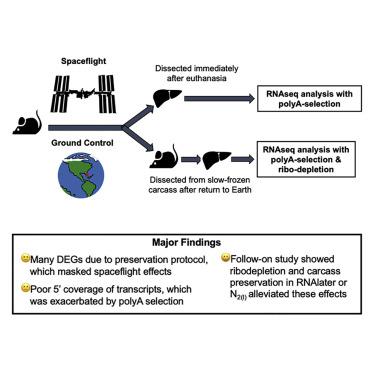iScience ( IF 5.8 ) Pub Date : 2020-11-25 , DOI: 10.1016/j.isci.2020.101733 San-Huei Lai Polo , Amanda M. Saravia-Butler , Valery Boyko , Marie T. Dinh , Yi-Chun Chen , Homer Fogle , Sigrid S. Reinsch , Shayoni Ray , Kaushik Chakravarty , Oana Marcu , Rick B. Chen , Sylvain V. Costes , Jonathan M. Galazka

|
To understand the physiological changes that occur in response to spaceflight, mice are transported to the International Space Station (ISS) and housed for variable periods of time before euthanasia on-orbit or return to Earth. Sample collection under such difficult conditions introduces confounding factors that need to be identified and addressed. We found large changes in the transcriptome of mouse tissues dissected and preserved on-orbit compared with tissues from mice euthanized on-orbit, preserved, and dissected after return to Earth. Changes due to preservation method eclipsed those between flight and ground samples, making it difficult to identify spaceflight-specific changes. Follow-on experiments to interrogate the roles of euthanasia methods, tissue and carcass preservation protocols, and library preparation methods suggested that differences due to preservation protocols are exacerbated when coupled with polyA selection. This has important implications for the interpretation of existing datasets and the design of future experiments.
中文翻译:

啮齿动物航天实验的RNAseq分析与样本采集技术混淆
为了了解响应太空飞行而发生的生理变化,将小鼠运送到国际空间站(ISS),并在安乐死在轨道上或返回地球之前收容不同的时间。在如此困难的条件下收集样品会引入一些混杂因素,需要加以识别和解决。我们发现,与返回轨道后被安乐死,保存和解剖的小鼠组织相比,解剖和保存在轨道上的小鼠组织的转录组有较大变化。由于保存方法引起的变化使飞行样本和地面样本之间的变化黯然失色,因此难以识别特定于航天的变化。后续实验以探讨安乐死方法,组织和car体保存方案的作用,文库的制备方法表明,与polyA选择结合使用时,由于保存方案引起的差异会加剧。这对现有数据集的解释和未来实验的设计具有重要意义。



























 京公网安备 11010802027423号
京公网安备 11010802027423号